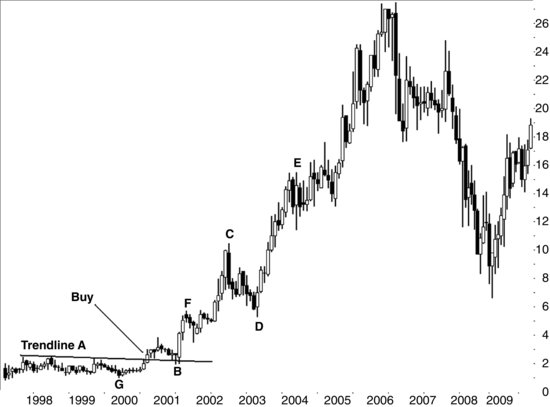CHAPTER 15
Trading 10-Baggers
Trading 10-baggers sounds like an oxymoron. Why consider trading stocks intended to be held for up to five years or longer? The answer is simple: to make money. A review of the charts gives hints how 10-baggers are born, live, and die, and using those hints can save time and money. Follow along as I explore the visual world of 10-baggers.
10-BAGGER BIRTH
Based on fundamental factors discussed in prior chapters, use the screening tools available on the Internet to pick a potential 10-bagger. After finding one, should you buy the stock? No. Why not? Because price may not rise for months or even years. That is where technical analysis helps by timing the entry. Let us look at a few charts to discover common elements that 10-baggers share during the birthing process.
Figure 15.1 shows a 10-bagger in BJ's Restaurants. If you bought the stock in April 1997 at about $1 per share, the stock would have peaked about a year later at 2.47. By June 2000, it would have been priced about $1.50. For a three-year hold time, 50 percent is not much of a gain for a 10-bagger, is it?
Figure 15.1 A 10-bagger in BJ's Restaurants, drawn on the monthly scale.

A doctor slapping the stock on the backside gives life to it, and price begins moving up. It pierces a trendline (cleverly labeled Trendline A) drawn along the price peaks, signaling a buy at about $2.
In the bear market ...
Get Fundamental Analysis and Position Trading: Evolution of a Trader now with the O’Reilly learning platform.
O’Reilly members experience books, live events, courses curated by job role, and more from O’Reilly and nearly 200 top publishers.

